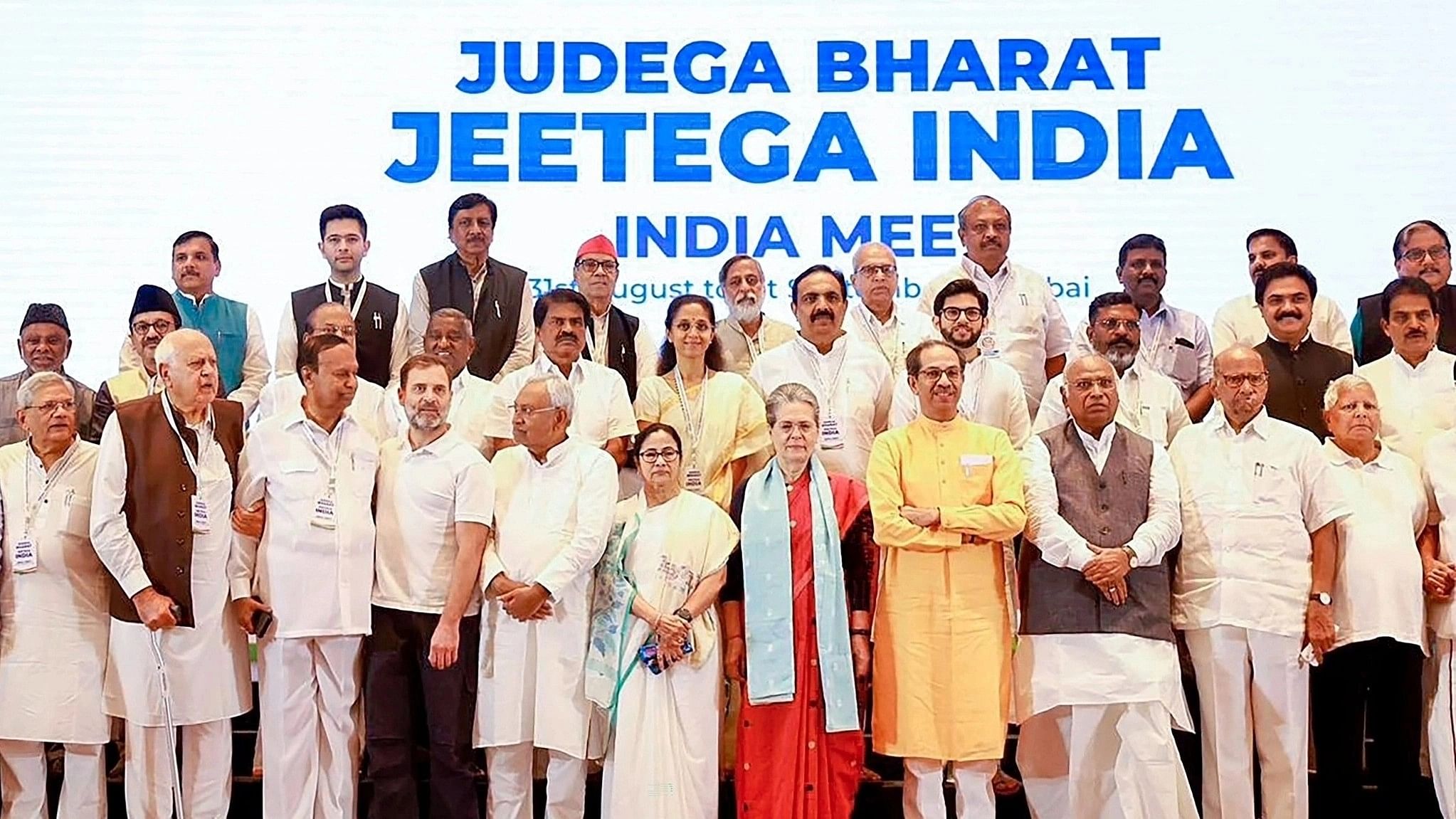
I.N.D.I.A leaders during the Opposition bloc's meeting.
Credit: PTI File Photo
This year is poised for an intense clash of ideologies as the stage is set for the upcoming Lok Sabha elections. The Hindi heartland, including Uttar Pradesh which sends 80 lawmakers to Lok Sabha, is witnessing two political phenomena: political mobilisation under the Narendra Modi-led Bharatiya Janata Party (BJP) leading up to the consecration of the Ram temple in Ayodhya, and an attempt to resurrect identity politics by the 28-party Opposition alliance I.N.D.I.A by invoking the demand for caste census, which they believe has the potential to deny Modi a third term as Prime Minister.
Many term it as the return of ‘Mandal vs Kamandal’ politics; but it will be a simplistic comparison between the two, as ‘Mandal’ and 'Kamandal’ of 2024 are remarkably different from their 1990s avatar.
The results of the recent assembly elections in Madhya Pradesh, Chhattisgarh, and Rajasthan, and, more importantly, the near absence of mass resistance on the ground from upper castes and visible counter-polarisation from the oppressed castes, may be seen as indicators that the ‘Mandal 2.0’ is an intellectual academic discussion for now. This also factors in the division among I.N.D.I.A allies and the BJP's politics that has transformed upper caste-driven Hindutva into an inclusive 'Bhartiyata’ of sorts.
The absence of mass resistance from the upper castes can be explained by the policy changes introduced in January 2019. Shortly after the BJP lost the 2018 assembly polls in Madhya Pradesh, Chhattisgarh, and Rajasthan to the Congress, the Modi-led government at the Centre announced a 10 per cent quota for the newly created economically weaker sections (EWS) in jobs and admissions in educational institutions without tampering with the existing reservation of 50 per cent for the Schedule Castes, the Schedule Tribes, and the Other Backwards Classes (OBCs). The move was to placate the BJP's traditional vote bank (the upper castes) without tampering with existing quota benefits for vulnerable sections. This decision is acting as a safety valve against any upper caste anti-quota movement, as was seen in the 1990s.
On August 7, 1990, then Prime Minister V P Singh surprised India by announcing a 27 per cent quota for the OBCs in government jobs based on the recommendations of the Mandal Commission. The brand of identity politics unleashed by the Mandal moment created leaders such as Mayawati, who became India’s first female Dalit Chief Minister in 1995, and gave a major fillip to the Dalit political voice.
However, today, Mandal 2.0 as a rallying ground for anti-BJP forces is not resonating with the people, even as the Congress has taken away from regional, caste-based parties the political issue of social justice. Kamandal 2.0 is also not catching up with people's imagination as far as Hindu consolidation on the Ram mandir is concerned, as happened in the 1990s.
The Mandal movement in the 1990s heated up politics because of a strong social upheaval from the forward castes — such an upheaval is missing today. The EWS quota is one of the reasons, another is that India today has moved ahead from where it was in the 1990s. While caste is still a social and political reality, India has gone through three decades of globalisation, which opened up various jobs and educational venues for upper castes in the private sector, and has led to the emergence of a huge middle class that resists major political upheaval from upper castes with the potential to generate a counter resistance from traditionally oppressed castes.
The consolidation of the OBCs, the SCs, and the STs on the issue of caste census is also missing due to the sub-categorisation of these groups, melting the idea of the OBCs or the SCs as a single political constituency due to the rise of individual caste consciousness. Corruption, and dynasty politics further dented the Opposition's chance to revive the social justice plank.
The lack of 1990s-like stirs, the absence of counter-mobilisation, and the recent assembly poll results doesn’t mean that identity politics has subsided or that caste consciousness has disappeared. These are potent political weapons that have given the Opposition a chance to set the narrative for the first time since 2014; it also can unite the Opposition and give the BJP a run for its money.
For this, I.N.D.I.A must come out of the secular-communal binary, and not limit social justice politics as a political response to counter BJP's Hindutva. A narrow focus on Hindutva will not work as today the Modi-regime has expanded it to ‘Bharatiyata’ to attract the OBC, the Dalits, and the Adivasi communities.
Caste is a social as well as a political reality, and the challenge before I.N.D.I.A is to redefine social justice and reinvent the caste card that can reignite 'caste consciousness' among socially oppressed, meaning 'caste in itself’ must be transformed into 'caste for itself’ which can challenge the BJP's grand social coalition built around a strong leader persona, cultural nationalism, and welfarism.
The 2024 general elections is going to revolve around the ideologies of Hindutva and social justice, which will eventually shape the future of India's democracy.
Mahendra Kumar Singh is a political commentator and teaches Political Science at DDU Gorakhpur University, Uttar Pradesh.
X: @MKSinghGkp
(Disclaimer: The views expressed above are the author's own. They do not necessarily reflect the views of DH.)